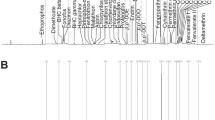Abstract
The information of the pesticide residues in herbal drug materials (HDMs) is not sufficient to support the scientific risk management so far. Therefore, 30 types of HDMs such as the herba of Artemisia montana were analyzed for 47 different pesticides. Among 292 samples, eight Chinese and one Korean HDMs were contaminated with five pesticides such as methoxychlor, DDT, γ-BHC, endosulfan, and procymidone (0.044–0.501 mg/kg). The detection rate of pesticides in the tested HDMs was determined as 3.1%. On critical observation of the detected amount of procymidone (0.501 mg/kg) and methoxychlor (0.382 and 0.312 mg/kg), further intensive monitoring of the pesticides might be necessary for HDMs.
Similar content being viewed by others
References
APVMA (2004) Reconsideration of approvals and registrations relating to procymidone, procymidone scope document, APVMA, Canberra, Australia. Available from: http://www.apvma.gov.au/chemrev/downloads/procymidone_scope.pdf. Accessed 17 May 2008
BCPC (2006) Pesticide manual, 14th edn. British Crop Protection Council Publications, Hampshire
Bown D (1995) Encyclopaedia of herbs and their uses. Dorling Kindersley, London
Busan, Seoul and Gyoungin Regional FDA (2004) Residual pesticide monitoring in foods and risk assessment. Annu Rep KFDA 8–2:1960–1968
Chevallier A (1996) The encyclopedia of medicinal plants. Dorling Kindersley, London
Choi DW, Kim JH, Cho SY, Kim DH, Chang SY (2002) Regulation and quality control of herbal drugs in Korea. Toxicology 181–182:581–586. doi:10.1016/S0300-483X(02)00487-0
Chungbuk Technopark Oriental Medicine Center (CTOMC) (2007) Establishment of the method for pesticide maximum residue limits in herbal medicines. Research project report, KFDA, Seoul
European Directorate for the Quality of Medicines (EDQM)—Council of Europe (COE) (2008) 2.8.13. Pesticide residues, European pharmacopoeia, 6th edn. Strasbourg, France, pp 3637–3638
EXTOXNET (1996) Methoxychlor, USDA/extension service/national agricultural pesticide impact assessment program. Available from: http://extoxnet.orst.edu/pips/methoxyc.htm. Accessed 16 May 2008
KCPA (2007) Agrochemicals use guide book. Korea Crop Protection Association, Seoul
KFDA (2002) Residual pesticide analysis in foods. Separate vol. In: Korea Food Code. Seoul, Korea, pp 258–263
KFDA (2007) Amendment of food standards, official amendment notice no. 2007-63, 06 September 2007. KFDA, Seoul
KFDA (2008) MRLs for pesticides in foods. KFDA, Seoul
Korea Pharmaceutical Traders Association (KPTA) (2003) The explanatory note for the discernment of herbal drug materials. A Publishing Company Daeyoung, Seoul
Natural Products Research Institute (NPRI) (1998) Medicinal plants in the Republic of Korea World Health Organization, western pacific series, no. 21. WHO Regional Office for the Western Pacific, Manila
Oh CH (2007a) Multi residual pesticide monitoring in commercial herbal crude drug materials in South Korea. Bull Environ Contam Toxicol 78:314–318. doi:10.1007/s00128-007-9176-9
Oh CH (2007b) Purification method for multi-residual pesticides in green tea. Nat Prod Commun 2:1025–1030
Rai V, Kakkar P, Misra C, Ojha SK, Srivastava N, Mehrotra S (2007) Metals and organochlorine pesticide residues in some herbal ayurvedic formulations. Bull Environ Contam Toxicol 79:269–272. doi:10.1007/s00128-007-9063-4
US EPA (2003) EPA national primary drinking water standards, EPA 816-F-03-016. Available from: http://www.epa.gov/safewater/consumer/pdf/mcl.pdf. Accessed 16 May 2008
Acknowledgments
This research was supported by Korea Food & Drug Administration, Korea. The author thanks Dr Lee, JK and Dr Yook, CS for providing Chinese HDM samples and high expertise for HDMs discernment, respectively.
Author information
Authors and Affiliations
Corresponding author
Rights and permissions
About this article
Cite this article
Oh, CH. Monitoring of Residual Pesticides in Herbal Drug Materials of Korea and China. Bull Environ Contam Toxicol 82, 639–643 (2009). https://doi.org/10.1007/s00128-009-9649-0
Received:
Accepted:
Published:
Issue Date:
DOI: https://doi.org/10.1007/s00128-009-9649-0




